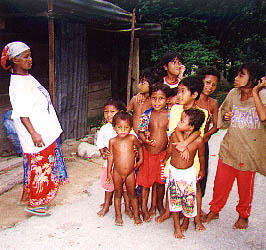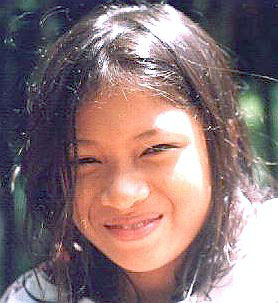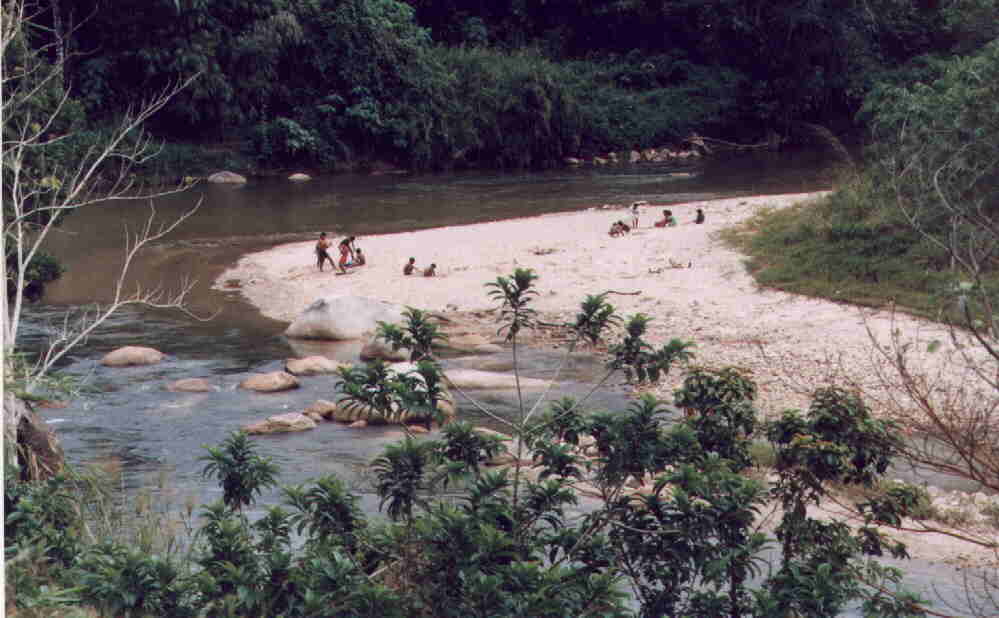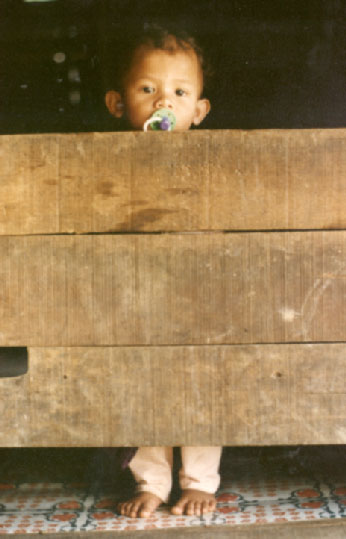
Kg. Pertak: Awa Lahai, the village healer, with a
playful bunch of carefree kids raised by the river.
Tuesday, February
2, 1999
Story by Pang Hin Yue
IT seems too much pain to bear for a toddler. One-and-a-half-year-old Anwar A'gan suffers from, among others, severe bronchitis and worm infestation. Lying on the bamboo floor with a high fever, he sucks on an empty feeding bottle in between coughs that send his tiny body retching.
His fever has persisted for four days but there is very little else his mother, Seri Inor, 30, and his seven older siblings can do except to comfort him.
They have no money. No medication. No food. No land. No job. No education. No piped water. No electricity. No support.
Seri's husband, who supported the family on earnings from the sale of petai and banana leaves, passed away last year leaving her to fend for their eight young children.
For Seri, a better life has been elusive since her family was forced out of their riverside village 15 years ago to make way for the Batu Dam near Batu Caves.
Orang Asli settlements like Seri's that fringe the rapidly urbanising Klang Valley have become further marginalised.
Ten-year old Sabrina, Seri's eldest daughter, for instance, has never been to school. Her younger siblings are likely to face the same destiny if the situation does not improve.
The community's repeated appeals to the Department of Orang Asli Affairs (Jabatan Orang Asli) to provide transport to schools have so far gone unheeded.
According to Mok Yusop, another victim of the Batu dam, the department's excuse is there are just too few children of school-going age to justify transportation.
But education is a basic right of all Malaysians. Is there any wonder why critics associate JOA - the Malay acronym for the Department of Orang Asli - with "Jual Orang Asli"?
Although the department was supposed to disband by 1990, it does not seem likely to happen anytime soon. "JOA is a powerful tool to control the Orang Asli," says one of its detractors, "and to take away their land."
As though it is not enough to deprive the children of Batu Dam of an education, the department has turned a deaf ear to the community's request for proper housing.
Adds an equally frustrated Moh Madili, his neighbour: "Now they (JOA) tell us there is no allocation because of the economic recession. They know where we stay but they refuse to help."
"Kita tidak dibagi apa-apa...tak ada duit..tak ada pampasan...(We were not given anything)," Seri say, recalling her family's relocation for the Batu Dam and the related recreational development thereafter.
Although Mok's family received compensation, it was just RM3,000, a paltry sum that did not reflect the cost of the land and dusun (fruit orchard) the Selangor Government took from them.
Even so, "we were told that we were overcompensated," says Mok bitterly.
Today, the youthful Mok is reduced to doing odd jobs and living with his family of five in a home that his urban counterparts would consider ramshackle.
The irony of having to work for the resort operator of Laman Bistari, whose chalets now occupy the very spot his village once stood, is not lost on him.
One wonders why Laman Bistari is allowed to be situated along the river near the dam, when the Orang Asli community there was uprooted by the Selangor Government because it was deemed "unsafe".
Will the same fate befall the approximately 600 Orang Asli in Pertak and Gerachi near Kuala Kubu Baru, now that the State Government has renewed its intention to dam the upper reaches of Selangor River? (See story on Page Five).
If the project were to proceed, it would be the fifth dam built at the expense of Orang Asli, notes Colin Nicholas of Centre for Orang Asli Concerns.
As early as 1965, both villages were indentified as Orang Asli areas but to date, they have not been gazetted as Orang Asli reserve.
Given the long history of Orang Asli being shortchanged in the name of development, it comes as no surprise that the villagers of Pertak -- where houses will be submerged for part of the reservoir -- and Gerachi, the proposed dam site, are vehemently objecting against the proposed dam.
"We don't want the dam. We want to stay put in our village. We are prepared to face the consequences," declares Ramsit Anong, the batin (headman) of Gerachi who also works as a tour guide for the whitewater rafting operators at Selangor River.
Similar protests can be heard in Pertak.
"My ancestors have been living on this land for hundreds of years. Why should we leave? What about our dusun?" Minah Anggung of Pertak cries, as she points to two majestic bongkok durian trees that her great grandmother had planted (and named) about a century ago.
Rashid Aus, Minah's brother-in-law, is also resisting resettlement because he is afraid he will get a raw deal. "We did not receive any help in the past to obtain seedlings for planting our fruit and rubber trees. We don't expect any in the future, either."
Perhaps their biggest complaint is that they were not consulted on the impending dam.
It underscores yet again the State governments' lack of transparency and a complete disregard for Orang Asli's rights when dealing with land issues.
When they learnt about the project earlier last month, the leaders of Pertak and Gerachi villages attempted to arrange a meeting with the State development authorities in Shah Alam on Jan 15. But they were prevented from doing so by the JOA on the basis that they had to "wait" for an official letter.
To this, KBB State Assemblyman Ch'ng Toh Eng, who is also the State Exco on environment, responds: "I saw them a few weeks ago in KKB but they did not raise the matter with me. But they are most welcome to see me. I am willing to hear their side of the story."
Still, Ch'ng is of the opinion that the dam should proceed to avoid a repeat of the water crisis that beset Selangor last year. But critics argue, is building a new dam the solution? Has the State Government explored other options? (See box).
Notwithstanding the environmental impact of damming a river, the absence of Orang Asli/indigenous people land rights remains an unresolved fundamental issue.
Typically, the authorities' justification for resettling Orang Asli is that it will help them to "integrate" and "assimilate" into mainstream society. But Nicholas who has been active in the Orang Asli struggle for the past decade does not think so.
It is the weakest yet most often used argument because "the ulterior motive is to take away the Orang Asli land", he asserts.
Legislation such as the Aboriginal Peoples Act and the National Land Code fail to protect Orang Asli interest. Consequently, the Orang Asli have been relegated to "tenants at will", always at the mercy of State governments. This is despite the fact they may be living on what has been their ancestral land for centuries.
One cannot help but question the double standards practised here and in the case of landless peasants who became landed farmers under the Felda schemes, says Nicholas.
They receive huge compensation when their land is taken for development but the same cannot be said for the Orang Asli and other indigenous people in Sabah and Sarawak, he observes.
"While the Orang Asli have rights to use the land," he explains, "they do not have rights to the land."
The extent of land gazetted as Orang Asli reserves speaks for itself.
Based on his doctoral thesis, Nicholas has found that the total land area gazetted as Orang Asli reserves shrank by 10 per cent to 18,587ha in 1996 from 20,667ha in 1990.
He notes that at the same time, of the 36,076 ha originally approved for gazetting in 1990, approval for 6,198ha has been withdrawn.
In short, as more land is taken up for development, the less there is for the Orang Asli.
Has "development" in any way increased the economic pie of the Orang Asli? The only way to gauge, says Nicholas, is to do a comparison before and after a resettlement. In most instances, the Orang Asli have been on the losing end.
He reasons that if the Government sincerely wants the Orang Asli to be on equal footing with fellow Malaysians, there is plenty of scope for resolving the matter peacefully.
"It's a myth," he insists, "that Orang Asli are anti-development."
It is a matter whether the authorities have the moral courage to give Orang Asli land titles that are rightfully theirs and engage them actively in the development process - and at the same, respect their cultural beliefs and heritage.
If the Selangor dam prevails despite opposition, we can only hope that the people of Pertak and Gerachi would not fall onto same path as their their Batu Dam counterparts did.

Kg. Pertak: Awa Lahai, the village healer, with
a
playful bunch of carefree kids raised by the river.



Tuesday, February
2, 1999
By Pang Hin Yue
"WE don't want a repeat of Bakun dam," says one of the likely key players in the construction of the proposed Selangor dam.
Speaking on condition of anonymity, he says he is well aware of the strong opposition by the Orang Asli communities in Pertak and Gerachi as well as the residents of Kuala Kubu Baru.
"It does not surprise me," he says, "that they are protesting against the dam."
Stressing that he does not want to repeat the mistakes of Ekran Bhd, the (former) developer of the controversial Bakun hydroelectric dam in Sarawak which for most part was shrouded in secrecy, he says he recognises the need to engage the affected people --- something missing? -- right at the very beginning.
But he also maintains that since the Selangor Government has not officially declared which private party will construct the dam, his company has yet to have the opportunity to talk to the affected communities.
(In a letter dated Sept 30 last year, the State Government granted permission to the proposed TSWA-Gamuda-KDEB consortium to prepare a feasibility study within an eight-month period for the dam project. But industry sources insist that the study did not mean that the consortium has secured the job of building and operating the dam.)
Nevertheless, the potential dam developer has already commissioned a social impact study to gauge the local communities' sentiments. The results are in the RM2 million detailed Environmental Impact Assessment which is expected to be released to the public in a week or two.
Not surprisingly, all of the 74 Orang Asli families surveyed oppose the dam while KKB residents want to know whether the dam will be safe.
Acknowledging the need to prevent the two Orang Asli communities from further alienation, he says if his company is given the job, he would ensure that see their demands are met. They include land titles and access to basic amenities, housing and school.
For now, the scenic Selangor River and its tributaries including Luit River in Pertak remain a favourite haunt of picnickers and whitewater rafting enthusiasts. There are at least three white water rafting operators here and a few of the Orang Asli work as their tour guides.
In fact, the Selangor Government had designated Selangor River as an eco-tourism spot. But since the water crisis in 1997, it has been viewed as the last source of water for the growing populace of the Klang Valley.
And if the proponents of the dam had their way, work would begin in the last quarter of this year and be completed by the end of the year 2002.
The proposed Selangor dam estimated to cost close to RM450 million was one of the 36 recommended for Peninsular Malaysia in the 1982 National Water Resources Study.
The Selangor government says the project has been revived because it does not want another water crisis. It is said that the State will experience critical water shortage by the year 2003 if steps are not taken now to build a new dam.
The damming of Selangor River requires a catchment area of 197,000ha. The reservoir (the area to be flooded to create a lake) spans 600ha and it will include the inundation of Gerachi, Pertak, a few privately-owned houses and a five-km stretch of the existing road leading to Fraser's Hill. A realignment of the road is already on the drawing board.
Only three per cent of the catchment area will be flooded, say the dam proponents. Pertak's dusun (fruit orchard) will remain intact.
The proponents argue that the upper reaches of Selangor River is the best option for the dam because it is the most economic in terms of land use.
Although there have been suggestions that one of its tributaries, Rening River, be dammed instead, they say this would flood an area three times the size of the proposed site.
The Selangor dam will have a storage capacity of 163 million cubic metres and a height of 115 metres, the highest in Selangor.
The dam proponents dismiss claims that the proposed site is geologically unsafe as "unfounded". From their geological survey, they assert, the area has a strong rock foundation with solid granite at the depth of seven metres.
But such revelations are unlikely to change the minds of the more vocal residents of KKB, Pertak and Gerachi.
"Damn the dam!" responds Dr A. Nathan, a dentist who has been living in KKB for the last 20 years. Still fresh in his mind is the 1996/97 floods caused by logging in Pertak. Houses in Ampang Pecah - about two km from KKB town - were inundated.
The logging had increased the incidence of landslides and river siltation, says Kit Leee who lives with the Orang Asli community of Pertak.
Angered by the lack of urgency on the part of the authorities to consult them, he foresees that environmental hazards would be magnified if the dam were to proceed.
The whitewater rafting operators are equally vociferous. Fearing that the river would be out of his reach, Ishak Mohamed of Khersonese Expeditions says his business would be seriously affected.
He urges the State government to consider another site and let the place be as "it is rich in biodiversity."
But proponents argue that the whitewater rafting operators could still continue with their venture. It may be a shorter route after the damming - 5km instead of the usual 7km - but they can carry out their activity all year round because "the river flow will be regulated."
They say with the dam, water would be released into the river during the dry season at a rate of no less than 300 million litres daily. This, they add, will improve the water quality during the dry season.
But environmentalists remain sceptical that the regulating of the water flow would not affect the mangroves in the downstream of Selangor River which the famous fireflies of Kampung Kuantan depend on.
"The fireflies issue is addressed in the detailed EIA," explains one of the proponents.
While dam proponents may have their rationale - after all, there is (lots of) money to be made for every new dam that is built - the question remains whether the State government explored other options.
Is the dam the only solution? Has the State Government conducted an assessment of the interdependence of forests, rivers and land to determine their sustainability? Has the State government effectively dealt with the chronic problem of water leakages?
Even the Drainage and Irrigation Department director-general Kheizrul Abdullah concedes that no attempt has been made by the respective State Governments to establish the capacity to supply water of each of the 150 river basins in the counrty.
He says it is easy to work out the amount of water that can be extracted sustainably from each basin.
Citing the case of water shortage in the Klang Valley due to increasing population and high consumption of water per capita, Kheizrul pleads: "We must avoid this from happening to other river basins."
To prevent another major water crisis, "the politicians will have to determine how best to spread out industrial and housing development," he says.
As long as the State governments fail to take into account the capacity of the river basin, there is no guarantee that adding new dams can solve water shortages.
It goes back to the vital issue of having coherent management of the country's natural resources, which at this juncture, is sorely lacking.

Last days of freedom
for the Temuan tribe?
q The detailed EIA will be made public this week or next. Contact Department of Environment headquarters for details.